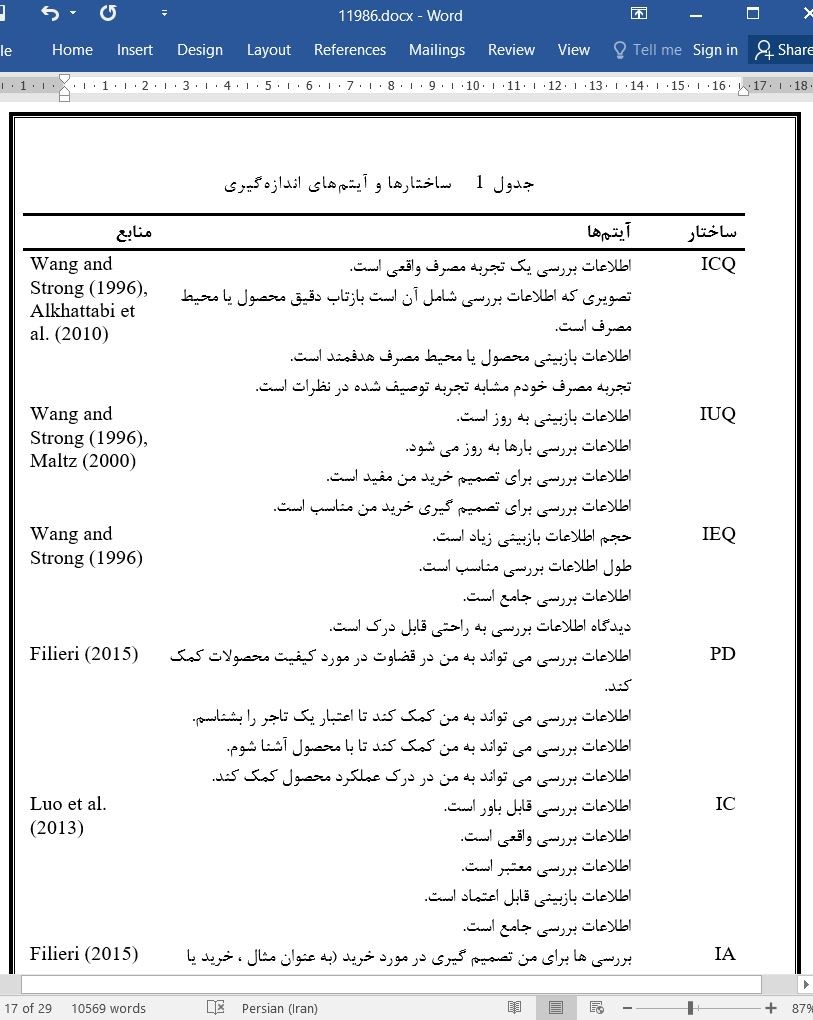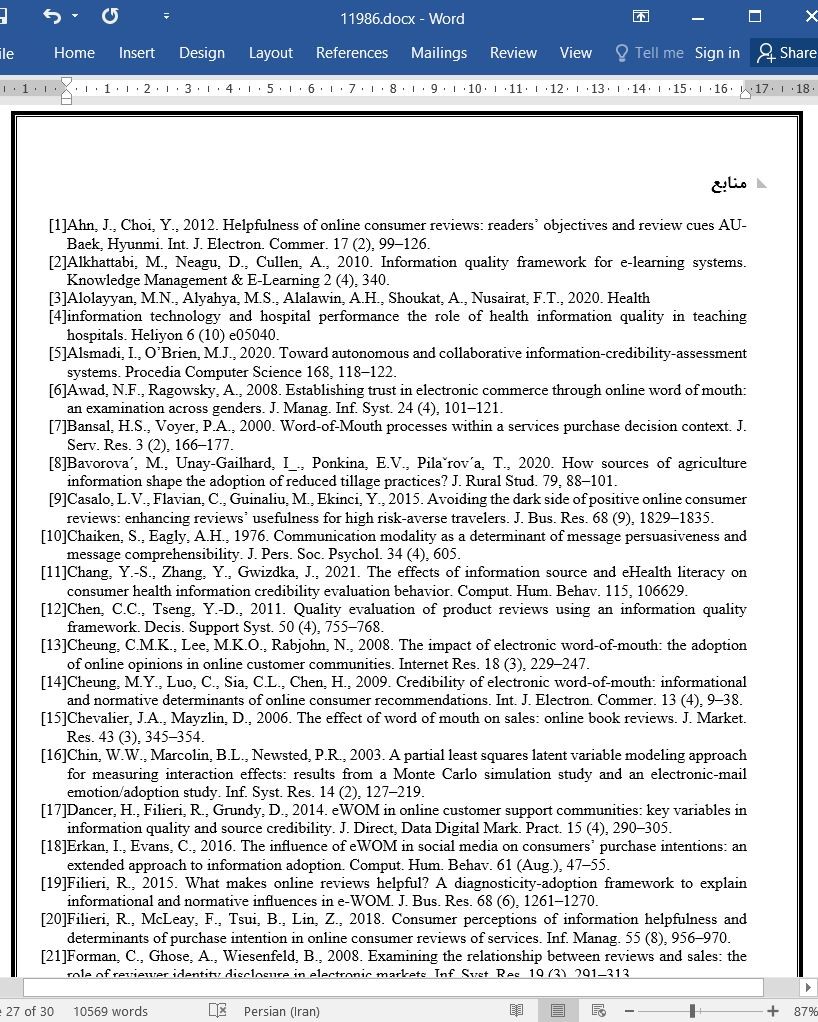
اثرات کیفیت اطلاعات بر پذیرش اطلاعات در بسترهای بازبینی رسانه های اجتماعی
چکیده
با ادغام رسانههای اجتماعی و تجارت الکترونیک ، پلتفرمهای مرور رسانههای اجتماعی مکانی را برای مشتریان فراهم میکنند تا اطلاعات را به اشتراک بگذارند و کلمات کلامی(دهان به دهان) الکترونیکی را ایجاد کنند (e-WOM). اطلاعات از کلمات دهانبهدهان الکترونیکی نقش مهمی در فرآیند تصمیمگیری مصرفکنندگان ایفا میکند. با این حال فرآیند پذیرش اطلاعات کاربران پلتفرمهای بررسی رسانههای اجتماعی هنوز نامشخص میباشد. بنابراین این مطالعه مدلی را ایجاد میکند تا بررسی کند که چگونه کیفیت اطلاعات بر اتخاذ اطلاعات فردی در پلتفرمهای تجارت الکترونیک تاثیر میگذارد و اثرات تعدیلکننده ریسک درک شده را بر کیفیت اطلاعات ، تشخیص درک شده و اعتبار اطلاعات بررسی میکند. مدلسازی معادله ساختاری و تحلیل رگرسیون برای تست مدل پیشنهادی مورد استفاده قرار گرفتهاند. نتایج نشان میدهد که کیفیت اطلاعات شامل کیفیت محتوا ، کیفیت بیان و کیفیت سودمندی میباشد که همه آنها به طور موثر بر اتخاذ اطلاعات در پلتفرمهای تجارت الکترونیک اجتماعی از طریق تشخیص و اعتبار اطلاعات درک شده تاثیر میگذارند. یافتهها همچنین نشان میدهند که ریسک درک شده به طور مثبت اثرات کیفیت اطلاعات بر روی تشخیص پذیری درک شده را تعدیل میکند.
مقدمه
فنآوری اینترنت نقش بزرگی در زندگی روزمره ما بازی کردهاست و تجمع اطلاعات عظیم افزایشیافته است که بر مدل معامله و محیط تجربه خردهفروشی آنلاین و اقتصاد به اشتراک گذاری تاثیر گذاشتهاست. (Olmedilla et al., 2019) با بلوغ تجارت اجتماعی و وب 0/3 ، به روز رسانی و بهینهسازی رسانههای اجتماعی ، تبادل اطلاعات بین مصرفکنندگان بیشتر تسریع شدهاست. برای حاملان پلتفرم اقتصادی و ارائه دهندگان خدمات و محصول ، اطلاعات دهانبهدهان الکترونیکی (e-WOM) ارائهشده در اینترنت تاثیر مهمی بر انتخاب و خرید محصولات یا خدمات دارد. هنگامی که تجارت محصول به صورت آفلاین با تعامل نقطه به نقطه انجام میشود ، انتشار کیفیت و ارزش محصول با کمک تبلیغات خردهفروش بوده و درک اثر واقعی توسط مصرفکنندگان رو در رو یا از طریق رسانه منتقل میشود. در حال حاضر نظرات مثبت یا منفی مشتریان آنلاین در مورد محصولات یا خدمات خاص در وب شکل اصلی اطلاعات دهانبهدهان الکترونیکی هستند. قبل از تصمیمگیری در مورد خرید ، مصرفکنندگان نه تنها به دنبال اطلاعات محصول یا سرویس هستند بلکه نظرات کاربران دیگر را نیز میخوانند. (Utz et al., 2012) این بررسیهای آنلاین به عنوان یک منبع اطلاعاتی اولیه برای مصرفکنندگان جهت تصمیمگیری در مورد خرید عمل میکنند. (Ahn and Choi, 2012; Jiang et al., 2016) بنابراین بسیاری از شرکتهای تجارت الکترونیک از ارزش بررسیهای آنلاین آگاه هستند و پلتفرمهای مبتنی بر وب خاصی را برای مشتریان جهت برقراری ارتباط و ارسال بررسیهای آنلاین خود ارائه میدهند (Chevalier and Mayzlin, 2006 Jiang et al., 2020a; Jiang et al., 2020b).
Abstract
With the integration of social media and e-commerce, social media review platforms provide consumers with a place to share information and create electronic word of mouth (e-WOM). Information from e-WOM plays an important role in consumers’ decision-making process. However, the information adoption process of users of social media review platforms remains unclear. Thus, this study builds a model to investigate how information quality affects individual information adoption on e-commerce platforms and explores the moderating effects of perceived risk on information quality, perceived diagnosticity, and information credibility. Structural equation modeling and regression analysis are used to test the proposed model. Results show that information quality consists of content quality, expression quality, and utility quality, all of which effectively affect the information adoption on socialized e-commerce platforms through perceived diagnosticity and information credibility. Findings also suggest that perceived risk positively moderates the effects of information quality on perceived diagnosticity.
1. Introduction
Internet technology has played a huge role in our daily life and the accumulation of massive information has soared, affecting the transaction model and experience environment of online retail and the sharing economy (Olmedilla et al., 2019). With the maturity of social commerce and Web 3.0, along with the update and optimization of social media, the exchange of information between consumers has been further accelerated. For economic platform carriers and providers of service and product, the electronic word of mouth (e-WOM) information presented on the Internet has an important effect on the selection and purchase of products or services. When product trading was done offline with point-to-point interaction, the dissemination of product quality and value was with the help of retailer advertising, and the real effect perception was transmitted by consumers face to face or through media. At present, consumers’ positive or negative online comments on specific products or services on the web are the main form of e-WOM information. Before making purchase decisions, consumers not only search for product or service information but also read reviews posted by other users (Utz et al., 2012). These online reviews serve as a primary information source for consumers to make purchase decisions (Ahn and Choi, 2012; Jiang et al., 2016). Thus, many e-commerce companies are aware of the value of online reviews and offer special web-based platforms for consumers to communicate and post their online reviews (Chevalier and Mayzlin, 2006 Jiang et al., 2020a; Jiang et al., 2020b).
چکیده
1 مقدمه
2 مرور مطالب
2-1 کیفیت اطلاعات
2-2 مدل احتمال ارزیابی (ELM)
2-3 ریسک درک شده
3 مدل تحقیق و فرضیات
3-1 کیفیت اطلاعات ، تشخیص پذیری درک شده و اتخاذ اطلاعات
3-2 کیفیت اطلاعات ، اعتبار اطلاعات و اتخاذ اطلاعات
3-3 اثرات تعدیلکننده ریسک درک شده
4 روش
4-1 توسعه ابزار
4-2 جمع اوری دادهها
5 تجزیه و تحلیل تجربی و نتایج
5-1 تحلیل مدل اندازهگیری
5-2 آزمایش فرضیه
6 بحث
7 پیامدها
7-1 مفاهیم نظری
7-2 مفاهیم عملی
8 جمعبندی
اعلام علاقه به رقابت
تقدیرات
ضمیمه A. دادههای موردنیاز
منابع
Abstract
1. Introduction
2. Literature review
2.1. Information quality
2.2. Elaboration likelihood model (ELM)
2.3. Perceived risk
3. Research model and hypotheses
3.1. Information quality, perceived diagnosticity, and information adoption
3.2. Information quality, information credibility, and information adoption
3.3. Moderating effects of perceived risk
4. Method
4.1. Instrument development
4.2. Data collection
5. Empirical analysis and results
5.1. Analysis of measurement model
5.2. Hypothesis testing
6. Discussion
7. Implications
7.1. Theoretical implications
7.2. Practical implications
8. Conclusions
Declaration of competing interest
Acknowledgments
References
- اصل مقاله انگلیسی با فرمت ورد (word) با قابلیت ویرایش
- ترجمه فارسی مقاله با فرمت ورد (word) با قابلیت ویرایش، بدون آرم سایت ای ترجمه
- ترجمه فارسی مقاله با فرمت pdf، بدون آرم سایت ای ترجمه



